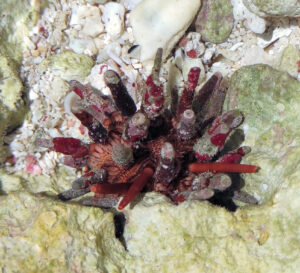Caribbean Slate Pencil Urchin, Eucidaris tribuloides
 Caribbean Slate Pencil Urchin, Eucidaris tribuloides. Underwater photograph taken in coastal waters off Akumal, Quintana Roo, March 2021. Photograph courtesy of Marina Sutormina, Stockholm, Sweden.
Caribbean Slate Pencil Urchin, Eucidaris tribuloides. Underwater photograph taken in coastal waters off Akumal, Quintana Roo, March 2021. Photograph courtesy of Marina Sutormina, Stockholm, Sweden.
Phylogeny: The Caribbean Slate Pencil Urchin, Eucidaris tribuloides (Lamarck, 1816), is a member of the Cidaridae Family of Pencil Urchins that is also known as the Club Urchin, the Mine Urchin, the Slate Pencil Urchin and the Sputnik Urchin, and in Mexico as erizo la’ piz. There are thirty Genera within the Cidaridae Family and seven individual species within the Eucidaris Genus. The color rubs from the blunt spines very easily, which is the origin of the common name.
Morphology: The Caribbean Slate Pencil Urchin has a small pumpkin-like test that has an overall length of 13 cm (5.0 inches) which has a 5.0 cm (2.0 inch) diameter test and ten columns of 5.0 cm (2.0 inch) thick spines attached. They have a brown, rust or tan colored body and thick orange-brown blunt spines that are set in all directions. Older spines can be identified by their white color, and are typically covered in algae and numerous epizoans. They have a unique five-point radial symmetry with their mouth, Aristotle’s Lantern, on the ventral side that has strong jaws and five beak-like teeth. Their ventral side also has numerous small transparent tube feet and provides them with mobility. Their mouths are equipped with hard, horned teeth that they utilize to scrape algae and other plant matter off rocks and corals.
Habitat and Distribution: The Caribbean Slate Pencil Urchin is normally found as a single benthic organism in crevices of the reef and over shallow waters amongst patchy areas of rocks, rubble, and seagrass within coral reefs. During daylight hours they anchor themselves on top of or under rocks, or within crevices, but have a very limited home range. They commonly reside in the intertidal zone to depths up to 50 m (165 feet) but have also been found at depths up to 700 m (2,300 feet). The Caribbean Slate Pencil Urchin is a resident of all Mexican waters of the Atlantic Ocean including the Gulf of Mexico and the east coast of the Yucatán Peninsula in the Caribbean.
Diet: The Caribbean Slate Pencil Urchin are primarily opportunistic herbivores and have a specialized tongue used for scraping algae from hard surfaces like rocks. However, they will also eat sponges, barnacles, mussels and dead fish or other sea creatures.
Predators: The Caribbean Slate Pencil Urchin utilize their colors for camouflage and their barb-laden spines for protection, but they are preyed upon by triggerfish and various species of wrasse.
Reproduction: The reproduction of the Caribbean Slate Pencil has not be studied extensively. Limited studies have shown that the reproductive cycles of this species tend to be sensitive to seasonal cycles, lunar cycles, and solar cycles. The Slate Pencil Urchin is sexually monomorphic. Reproduction occurs via broadcast spawning where the females release hundreds of thousands of eggs into the surrounding water concurrently with the release of sperm by males. After fertilization, the larvae will attach to substrate and taking two years to reach adult size.
Human Impact: The Caribbean Slate Pencil Urchin are considered to be highly invasive in certain parts of their range. They are utilized by the aquarium trade on a limited basis. They have been utilized by the scientific community as a model for development and evolutionary biology.
Synonyms: Cidaris (Gymnocidaris) tribuloides, Cidaris annulata, Cidaris minor, Cidaris tribuloides, Cidarites tribuloides, Eucidaris clavata, Eucidaris tribuloides africana, Eucidaris tribuloides africana f. attenuata, Eucidaris tribuloides var. africana